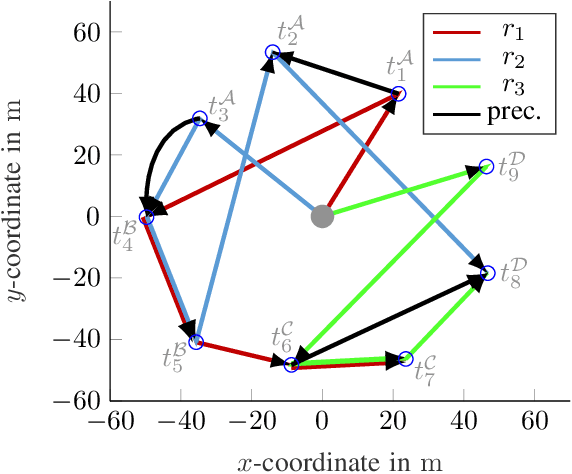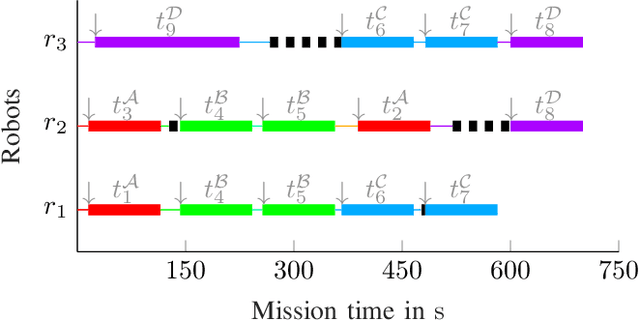Fabian Meyer
Kinematic Orienteering Problem With Time-Optimal Trajectories for Multirotor UAVs
Nov 30, 2022Abstract:In many unmanned aerial vehicle (UAV) applications for surveillance and data collection, it is not possible to reach all requested locations due to the given maximum flight time. Hence, the requested locations must be prioritized and the problem of selecting the most important locations is modeled as an Orienteering Problem (OP). To fully exploit the kinematic properties of the UAV in such scenarios, we combine the OP with the generation of time-optimal trajectories with bounds on velocity and acceleration. We define the resulting problem as the Kinematic Orienteering Problem (KOP) and propose an exact mixed-integer formulation together with a Large Neighborhood Search (LNS) as a heuristic solution method. We demonstrate the effectiveness of our approach based on Orienteering instances from the literature and benchmark against optimal solutions of the Dubins Orienteering Problem (DOP) as the state-of-the-art. Additionally, we show by simulation \color{black} that the resulting solutions can be tracked precisely by a modern MPC-based flight controller. Since we demonstrate that the state-of-the-art in generating time-optimal trajectories in multiple dimensions is not generally correct, we further present an improved analytical method for time-optimal trajectory generation.
* This work was published in IEEE Robotics and Automation Letteres, VOL. 7, NO. 4, OCTOBER 2022
Trajectory-based Traveling Salesman Problem for Multirotor UAVs
Nov 30, 2022Abstract:This paper presents a new method for integrated time-optimal routing and trajectory optimization of multirotor unmanned aerial vehicles (UAVs). Our approach extends the well-known Traveling Salesman Problem by accounting for the limited maneuverability of the UAVs due to their kinematic properties. To this end, we allow each waypoint to be traversed with a discretized velocity as well as a discretized flight direction and compute time-optimal trajectories to determine the travel time costs for each edge. We refer to this novel optimization problem as the Trajectory-based Traveling Salesman Problem (TBTSP). The results show that compared to a state-of-the-art approach for Traveling Salesman Problems with kinematic restrictions of UAVs, we can decrease mission duration by up to 15\%.
* This work was published at 2021 17th International Conference on Distributed Computing in Sensor Systems (DCOSS)
Multi-Robot Task Allocation and Scheduling Considering Cooperative Tasks and Precedence Constraints
May 08, 2020



Abstract:In order to fully exploit the advantages inherent to cooperating heterogeneous multi-robot teams, sophisticated coordination algorithms are essential. Time-extended multi-robot task allocation approaches assign and schedule a set of tasks to a group of robots such that certain objectives are optimized and operational constraints are met. This is particularly challenging if cooperative tasks, i.e. tasks that require two or more robots to work directly together, are considered. In this paper, we present an easy-to-implement criterion to validate the feasibility, i.e. executability, of solutions to time-extended multi-robot task allocation problems with cross schedule dependencies arising from the consideration of cooperative tasks and precedence constraints. Using the introduced feasibility criterion, we propose a local improvement heuristic based on a neighborhood operator for the problem class under consideration. The initial solution is obtained by a greedy constructive heuristic. Both methods use a generalized cost structure and are therefore able to handle various objective function instances. We evaluate the proposed approach using test scenarios of different problem sizes, all comprising the complexity aspects of the regarded problem. The simulation results illustrate the improvement potential arising from the application of the local improvement heuristic.
 Add to Chrome
Add to Chrome Add to Firefox
Add to Firefox Add to Edge
Add to Edge